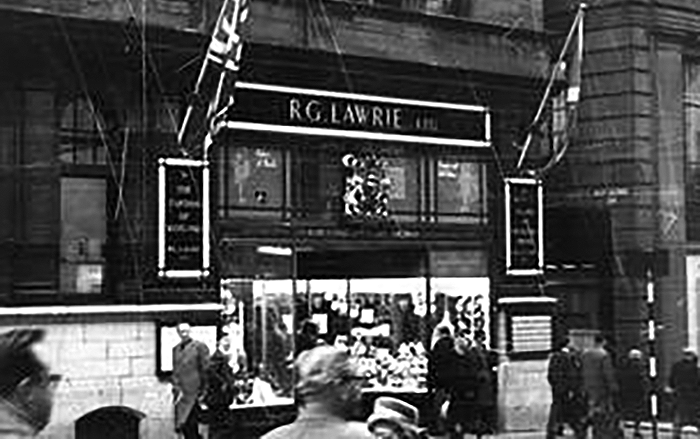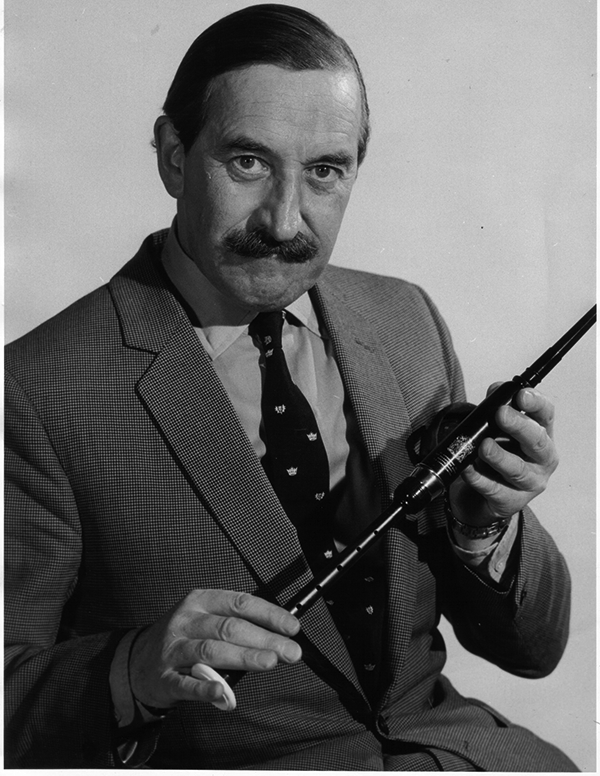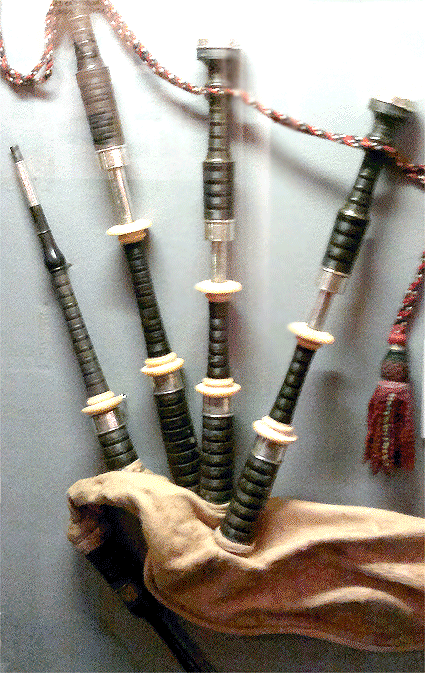We have recently run history articles mentioning the famous Peter Henderson pipemaking firm. Equally renowned are the instruments of their rivals, RG Lawrie. Before he passed away Jimmy McIntosh forwarded to our editor the following article. In an accompanying note Jimmy wrote, ‘I had lunch one day in Stirling with Arthur Lawrie and he gave me this history of the RG Lawrie company. I think it is very interesting and I am sure it would be to other pipers. Arthur seemed to be the only one left from the firm at the time I met him.’ The company’s shop in Renfield Street, Glasgow, is pictured below in the early 1960s.

The company was started in 1881 by Robert George Lawrie who was a journeyman ivory billiard ball turner. The recent reforms of the British Army had formalised the existence of pipes and drums playing together, and there appeared to be an increasing market for such iterms.
Having already served as a turner of bowling green bowls, he incorporated this activity at the same time. The original premises were at 63 John Street, Glasgow, which had been the birthplace of one Colin MacLiver, who masqueraded in the regular Army as Colin Campbell and became a Field Marshal, dying in 1868. This was the man who commanded the Thin Red Line at Balaclava.

By 1883 diversification had taken place as a result of demand and the company was then making not only bagpipes and bowling green bowls but also Highland dress and employed some 20 people. Not being a piper himself Robert Lawrie had to rely on advice from various people including John MacColl (whose son Dougal eventually became the bagpipe foreman turner). John MacDougall Gillies was for some reason mentioned, although it is known that he was emplotyed by Messrs Peter Henderson.
In either 1909 or 1919 the company purchased Gavin C. MacDougall, Bagpipe Makers, Aberfeldy, founded in 1816. The price is unknown, as are any of the details concerning the purchase, although it can be safely said that MacDougall’s tools and sizes were doubtless used since their reputation for quality instruments was very high.
The Great War reduced the number of skilled male workers in the company very considerably, some 22 going to serve, but at the same time the demand for bagpipes rocketed, as did the requirement for bugles and drums, resulting in the employment of very young and older men to produce sufficient instruments to satisfy demand.
After the Great War, in the years between the wars, Pipe Major Robert Reid, late of the HLI, was employed in a sales capacity and also, obviously, as an adviser.

He was succeeded, when he went to start his own business, by Donald MacDougall, late of the Cameronians, Scottish Rifles. During that period, up until the Second War, the use of cocus and partridge wood was greatly reduced except for pipe chanters, but by the beginning of the Second World War only African blackwood and Mozambique ebony continued to be used.
Once again, as a result of the war, the kilt making, sporran making and, by no means last, bagpipe making functions of the factory had to expand – by a factor of four!
At the end of the war the popularity of civilian pipe bands increased even further at home and overseas and the company was then by far the biggest in bagpipe manufacturing in the world.
In fairness it has to be said that although their reputation for quality manufacture of drones and, in particular, practice chanters, was very high, they never seemed to produce a pipe chanter which was consistently excellent, although Hector MacFadyen and Donald MacLean of Lewis both won Gold Medals with specific Lawrie pipe chanters.
- To be continued.
















This is an error as regards when RG Lawrie actually started to make pipes. He was, as the article has stated, an ivory turner and bowling green ball maker. If one looks at the Glasgow trade directory of 1899, no mention of bagpipes but in 1900 onwards, suddenly bagpipes appear in his trade advertisements. I own a set of very early STAMPED ivory Lawries ‘RG Lawrie Glasgow’ that would date 1900 or later which is very scarce. (I’ve seen two original S/I ‘RG Lawrie Glasgow’ Stamped Lawries with the silver stamped RG Lawrie dated respectively 1901 and 1903) but nothing before that. If any piper out there has a set pre 1900 that’s stamped and has original RG Lawrie silver from before that date then this would be a major discovery.
I was receiving The Piping Press via email regularly but recently I have not been receiving any Piping Press emails. Please ensure that I am on your recipient list. Thank you, Alex.